What Is Puerto Rican Food? It’s more than just a question; it’s an invitation to explore a vibrant tapestry of flavors, aromas, and traditions. FOODS.EDU.VN invites you on a gastronomic adventure to uncover the heart and soul of Puerto Rican cuisine, revealing its unique blend of Spanish, African, and Taíno influences. Discover the history, ingredients, and iconic dishes that make Puerto Rican food a culinary treasure.
1. Unveiling the Essence: What Is Puerto Rican Food?
Puerto Rican food, affectionately known as “comida criolla,” is a captivating reflection of the island’s rich cultural heritage. It’s a delightful fusion of flavors and cooking techniques passed down through generations, making it a truly unique culinary experience. From savory stews to crispy fritters and mouthwatering desserts, Puerto Rican cuisine offers a diverse and satisfying array of dishes. Let’s dive into the key elements that define this delicious food.
1.1 A Tri-Continental Heritage: The Roots of Puerto Rican Cuisine
Puerto Rican food is a beautiful marriage of three distinct culinary traditions:
- Spanish Influence: Spanish colonizers brought ingredients like olive oil, garlic, onions, citrus fruits, and pork to the island. They also introduced dishes like paella, which evolved into the Puerto Rican version called arroz con pollo.
- African Influence: Enslaved Africans brought their culinary expertise, contributing ingredients like plantains, yams, and okra. They also introduced techniques like deep-frying and slow-cooking, which are prominent in many Puerto Rican dishes.
- Taíno Influence: The indigenous Taíno people were the original inhabitants of Puerto Rico. They contributed ingredients like corn, beans, and tropical fruits, as well as cooking methods like barbecuing.
1.2 The Sofrito Symphony: The Aromatic Foundation
Sofrito is the cornerstone of Puerto Rican cuisine, a fragrant base for countless dishes. This vibrant blend typically includes onions, garlic, bell peppers, cilantro, and culantro (a stronger version of cilantro). The ingredients are finely chopped and sautéed in olive oil until softened and fragrant, creating a flavorful foundation for stews, rice dishes, and more.
1.3 Essential Ingredients: The Building Blocks of Flavor
Puerto Rican cuisine relies on a variety of key ingredients that contribute to its distinctive flavors:
| Ingredient | Description | Use |
|---|---|---|
| Plantains | A starchy, banana-like fruit that is typically cooked before eating. | Used to make tostones (fried plantains), mofongo (mashed plantains), and pasteles (plantain dough). |
| Rice | A staple grain that is served with almost every meal. | Used in arroz con gandules (rice with pigeon peas), arroz con pollo (rice with chicken), and as a side dish. |
| Beans | A versatile legume that is often cooked with sofrito and spices. | Used in habichuelas guisadas (stewed beans) and as a side dish. |
| Pork | A popular meat that is often roasted, grilled, or stewed. | Used in pernil (roasted pork shoulder), lechón (whole roasted pig), and as a filling for empanadas. |
| Seafood | Abundant due to the island’s location. | Used in ensalada de pulpo (octopus salad), bacalaitos (codfish fritters), and asopao (rice soup). |
| Adobo | A versatile seasoning blend. | It’s often used to season meats, poultry, and seafood. |
| Sazón | Another seasoning blend, often containing annatto for color and flavor. | Used to add flavor and color to rice, beans, and stews. |
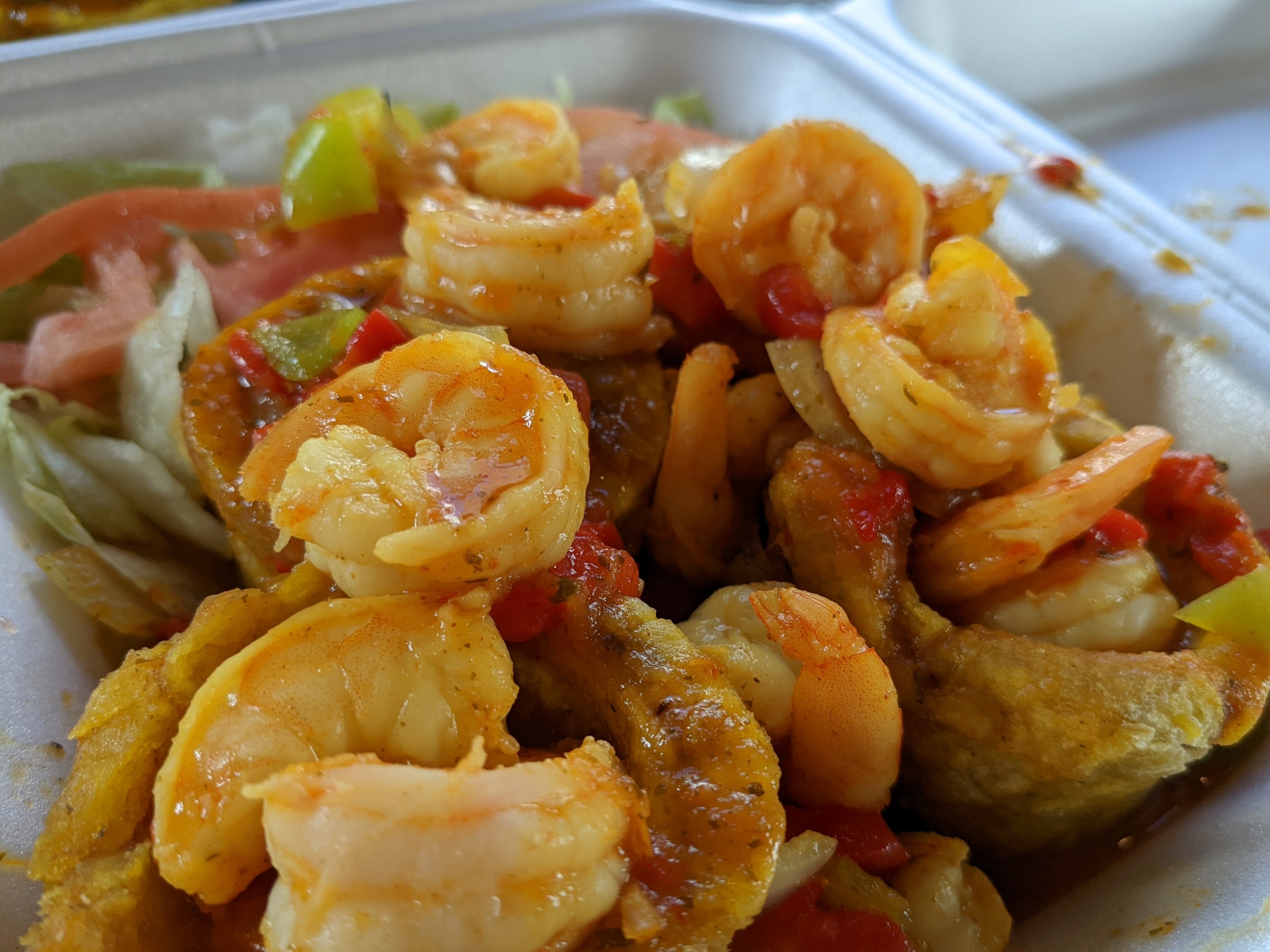
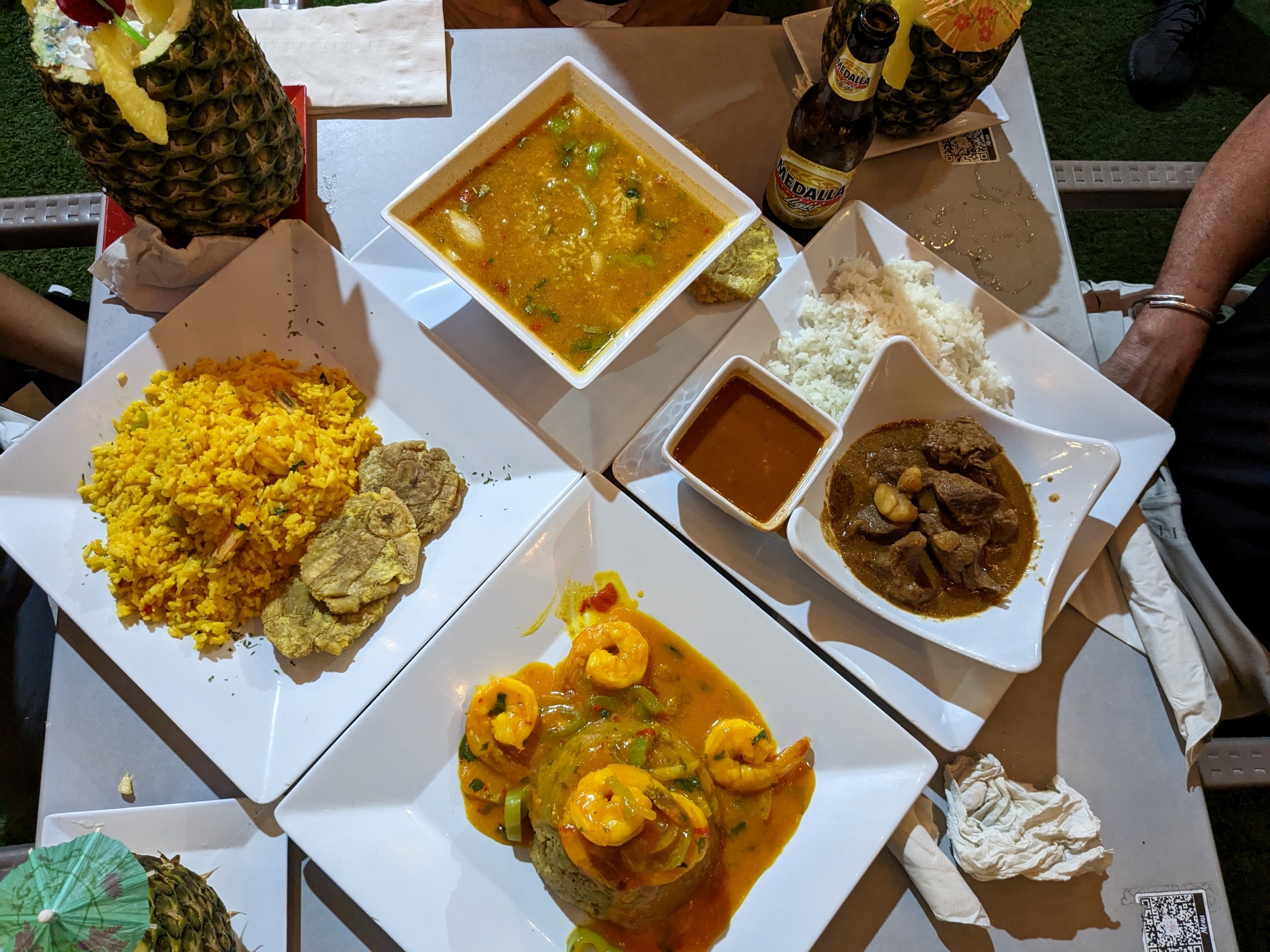
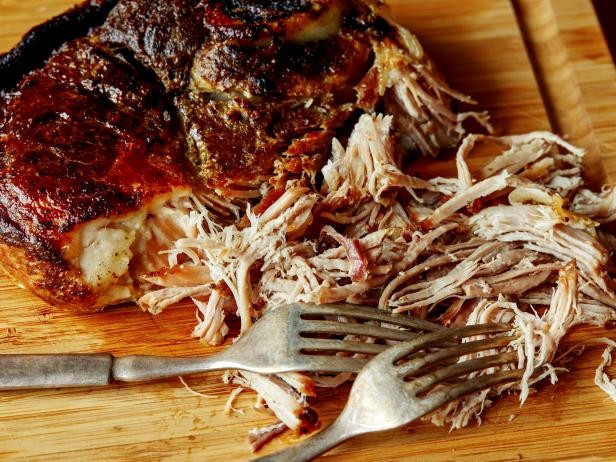
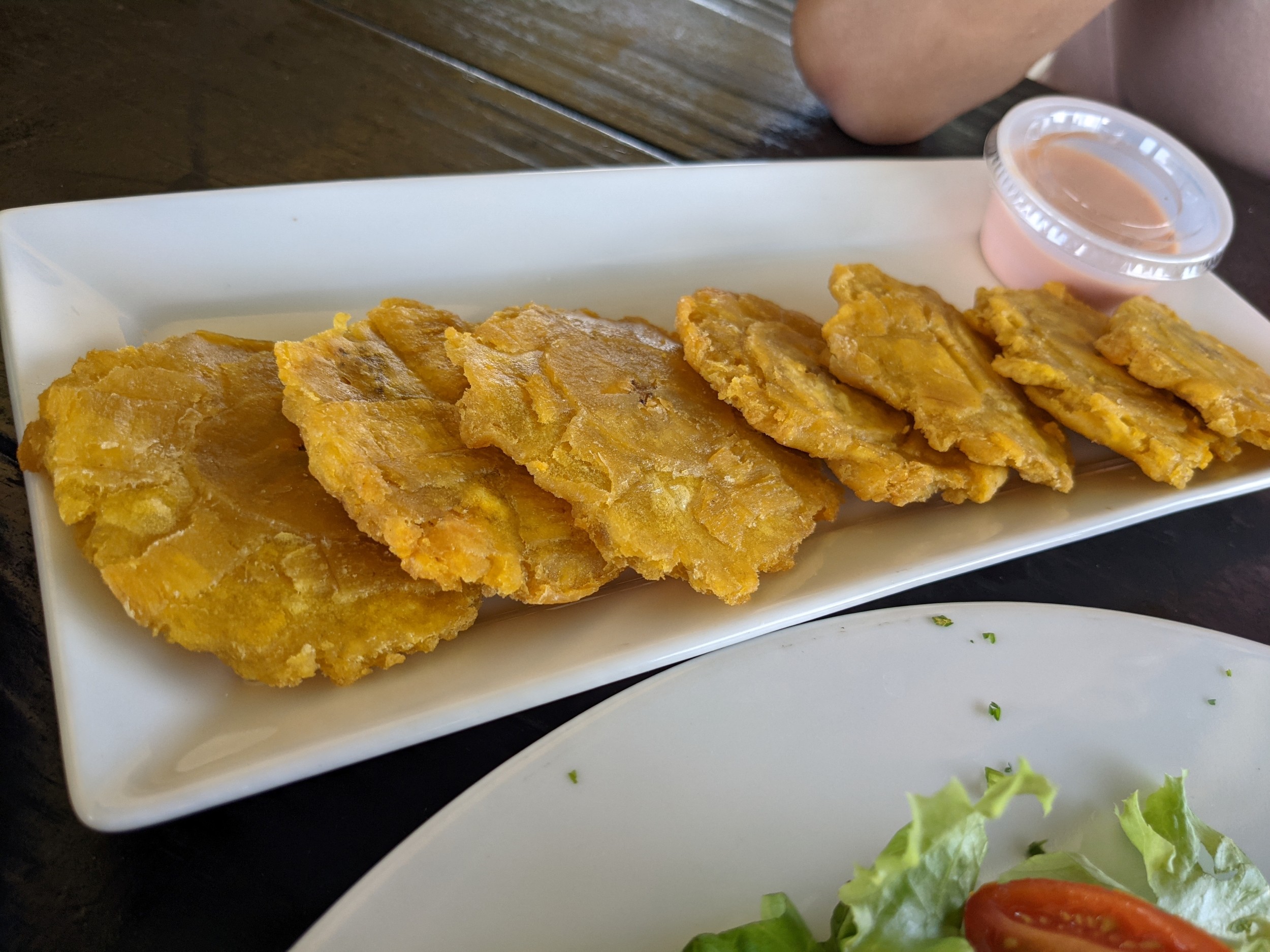
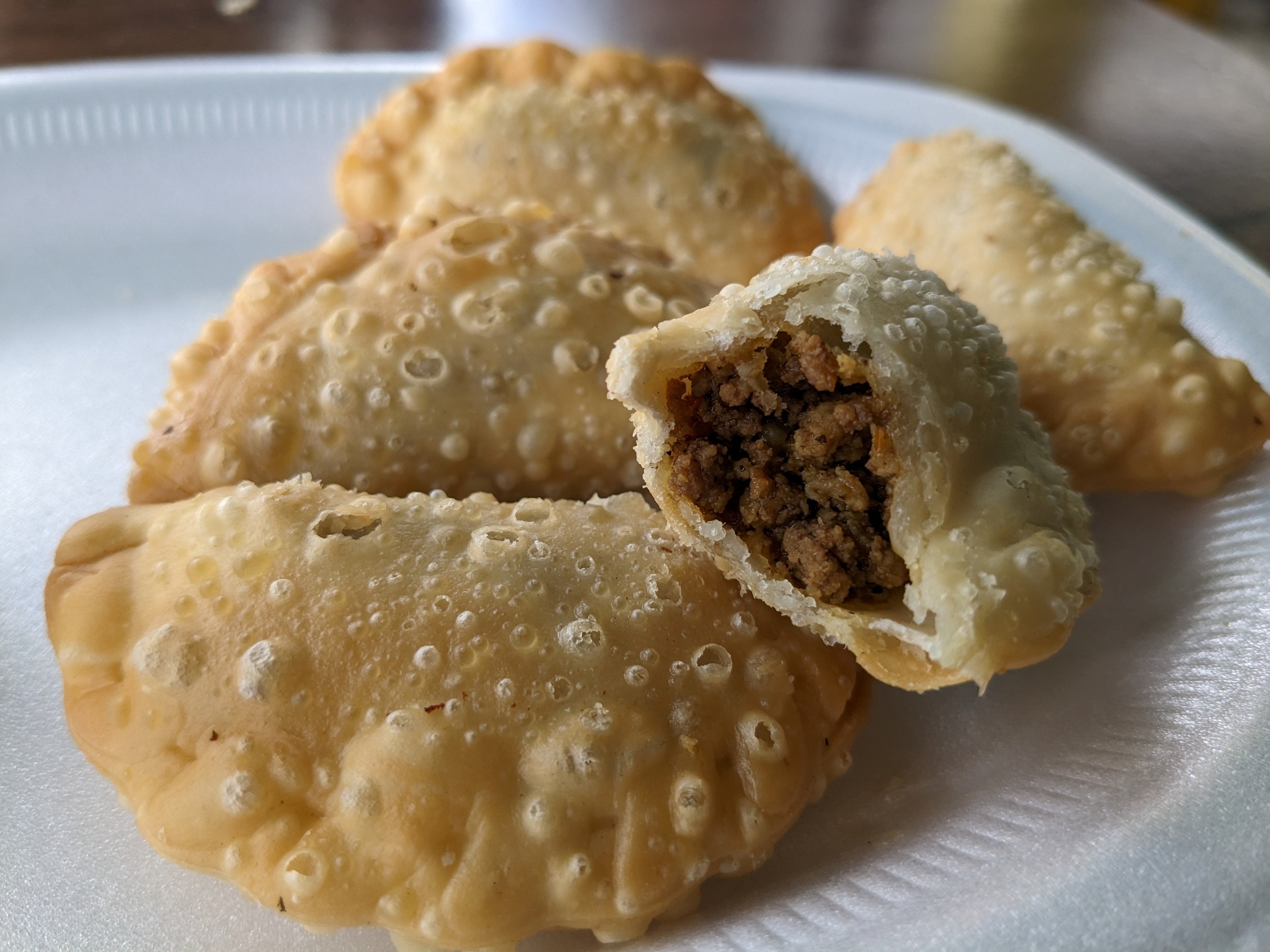
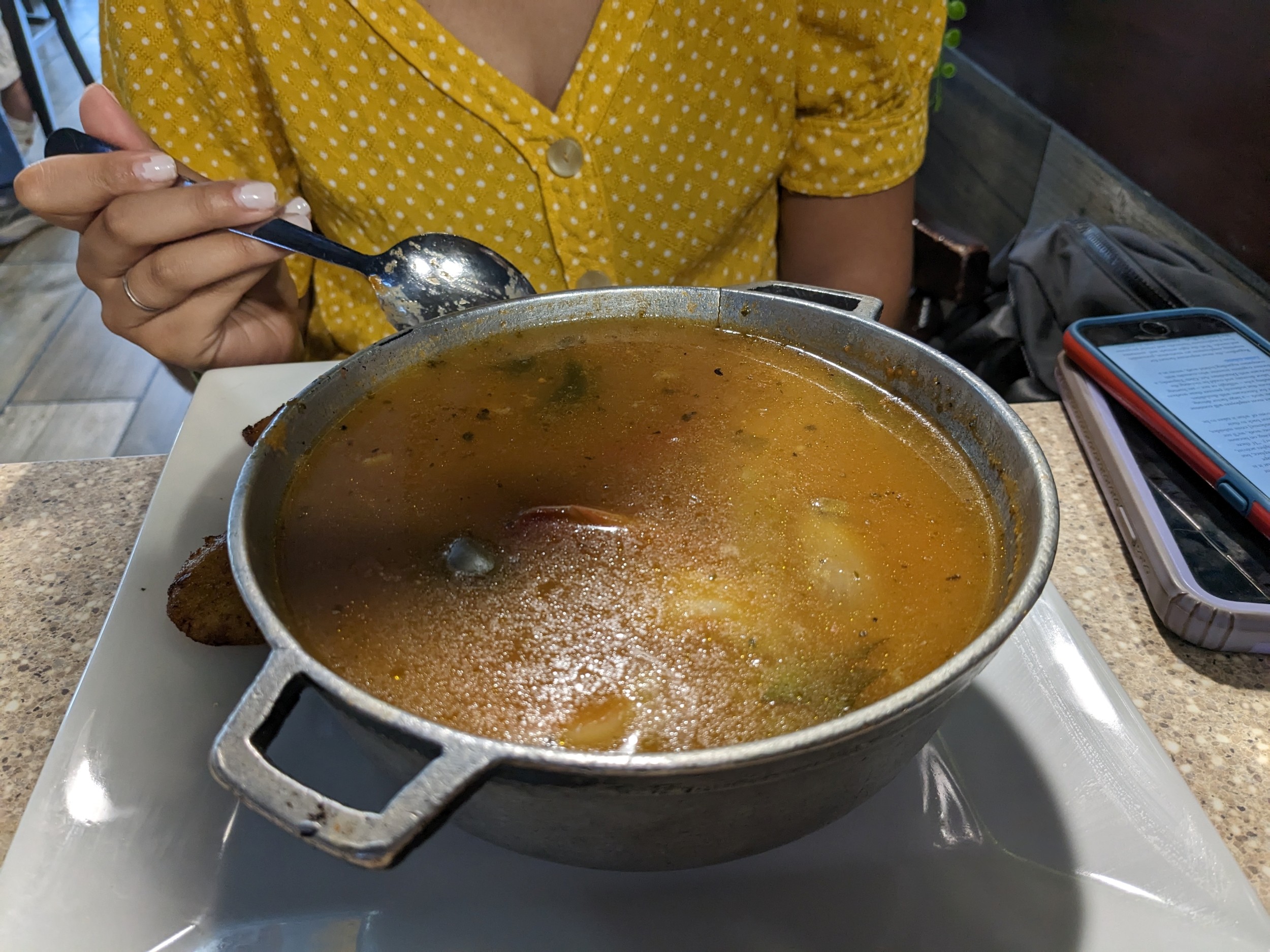
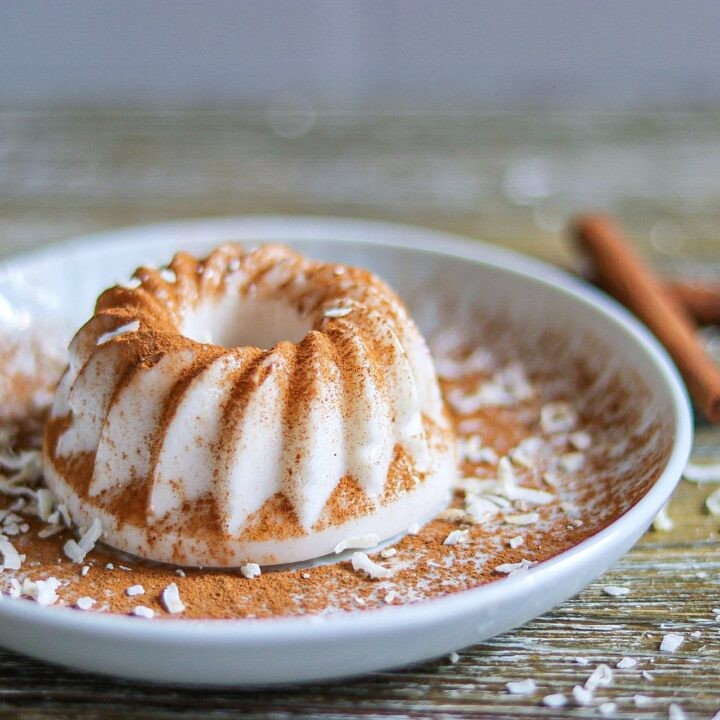
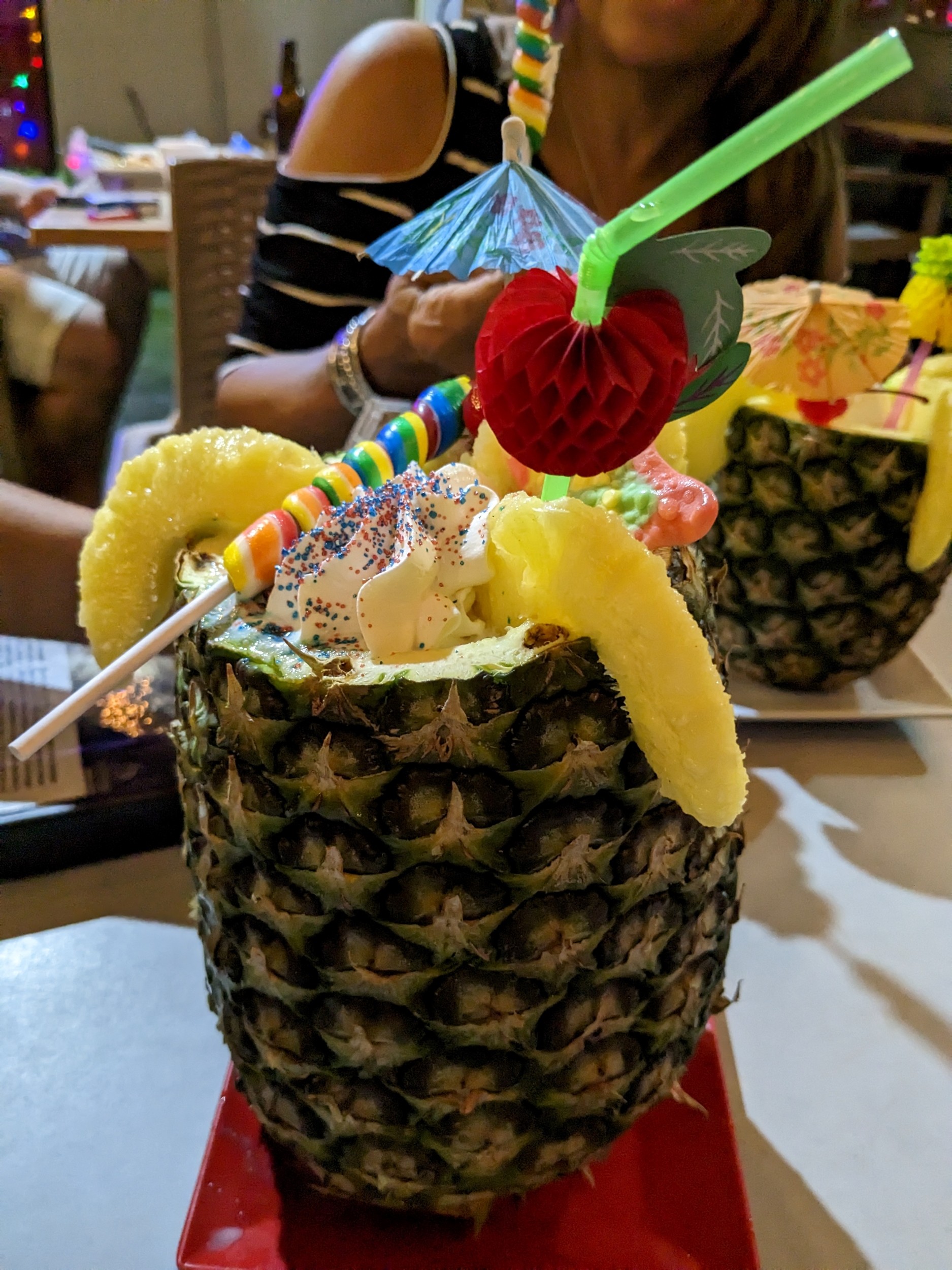

1.4 A Culinary Vocabulary: Key Terms to Know
To fully appreciate Puerto Rican food, it helps to familiarize yourself with some common culinary terms:
- Mofongo: Mashed plantains, typically fried and seasoned with garlic and other spices.
- Tostones: Fried plantain slices, often served as a side dish or appetizer.
- Arroz con Gandules: Rice with pigeon peas, a classic Puerto Rican dish.
- Pernil: Roasted pork shoulder, a staple during holidays and celebrations.
- Pasteles: Dough made from grated green bananas, plantains, or yuca, filled with meat and steamed in banana leaves.
- Empanadillas: Savory pastries filled with meat, cheese, or other fillings, then fried or baked.
- Alcapurrias: Fritters made from grated green bananas and yautía (taro root), filled with meat and fried.
2. A Gastronomic Tour: Iconic Puerto Rican Dishes to Savor
Now that you have a foundational understanding of Puerto Rican cuisine, let’s embark on a culinary journey and explore some of the island’s most iconic dishes:
2.1 Mofongo: The King of Puerto Rican Cuisine
Mofongo reigns supreme as one of the most beloved dishes in Puerto Rico. It’s a flavorful and satisfying dish made from mashed fried plantains, garlic, and pork cracklings (chicharrón). The plantains are typically mashed in a wooden pilón (mortar and pestle) and then formed into a mound or bowl. Mofongo can be enjoyed on its own or filled with various meats, seafood, or vegetables.
2.2 Arroz con Gandules: A Festive Rice Dish
Arroz con gandules is a quintessential Puerto Rican rice dish that is especially popular during the holiday season. It features rice cooked with pigeon peas (gandules), sofrito, and various seasonings. The rice is often infused with annatto oil, giving it a vibrant yellow color. Arroz con gandules is a flavorful and comforting dish that is perfect for sharing with family and friends.
2.3 Pernil: The Star of the Feast
Pernil is a succulent roasted pork shoulder that is a centerpiece of many Puerto Rican celebrations, especially during Christmas. The pork is marinated overnight in a mixture of garlic, oregano, and other spices, then slow-roasted until tender and flavorful. The crispy skin and juicy meat make pernil an irresistible dish.
2.4 Tostones: Crispy Plantain Delights
Tostones are twice-fried plantain slices that are a popular side dish or appetizer in Puerto Rico. Green plantains are sliced, fried until softened, then flattened and fried again until golden brown and crispy. Tostones are typically seasoned with salt and served with a dipping sauce, such as mayo-ketchup (a mixture of mayonnaise and ketchup).
2.5 Pasteles: A Labor of Love
Pasteles are a traditional Puerto Rican dish made from grated green bananas, plantains, or yuca (cassava). The dough is filled with a savory mixture of meat, olives, and seasonings, then wrapped in banana leaves and steamed. Making pasteles is a labor-intensive process that is often done as a family tradition during the holidays.
2.6 Empanadillas: The Perfect Snack
Empanadillas are the quintessential street food that you can never go wrong with. These savory turnovers are filled with ground beef, chicken, or seafood. Seasonings, vegetables, and cheese complement the main ingredients, making for a delicious combination of flavors. They are then fried until crispy and golden brown.
2.7 Asopao: A Hearty Rice Soup
Asopao is a comforting rice soup that is similar to gumbo or jambalaya. It can be made with chicken, shrimp, beef, or gandules (pigeon peas). Asopao typically includes rice, sofrito, tomatoes, onions, and olives. It’s a hearty and flavorful soup that is perfect for a chilly day.
2.8 Tembleque: A Sweet Coconut Treat
Tembleque is a creamy coconut pudding that is a popular dessert in Puerto Rico. It’s made with coconut milk, cornstarch, sugar, and cinnamon. Tembleque is typically chilled until firm and then sprinkled with cinnamon before serving. It’s a light and refreshing dessert that is perfect for a hot day.
2.9 Pina Colada: A Taste of Paradise
The world-class drink was actually invented in Puerto Rico. This heavenly cocktail is infused with rum, coconut milk, pineapple juice, and garnished with a slice of pineapple and a cherry. The Piña Colada radiates a vibe of pure paradise like no other beverage.
3. Beyond the Plate: The Cultural Significance of Puerto Rican Food
Puerto Rican food is more than just sustenance; it’s a vital part of the island’s culture and identity. Food plays a central role in family gatherings, celebrations, and traditions. Sharing a meal is a way to connect with loved ones, preserve cultural heritage, and express hospitality.
3.1 Food as a Symbol of Community
In Puerto Rican culture, food is often prepared and enjoyed in large quantities, emphasizing the importance of sharing and community. Family recipes are passed down through generations, preserving culinary traditions and strengthening family bonds. During holidays and special occasions, families gather to prepare elaborate feasts, with each member contributing their skills and expertise.
3.2 Food as a Reflection of History
Puerto Rican cuisine reflects the island’s complex history and cultural influences. The blending of Spanish, African, and Taíno traditions has created a unique culinary identity that is both diverse and flavorful. Each dish tells a story about the island’s past, from the indigenous ingredients to the colonial influences and the African contributions.
3.3 Food as a Source of Pride
Puerto Ricans take great pride in their culinary heritage. Food is a way to express their cultural identity and share their traditions with the world. Puerto Rican chefs and home cooks are passionate about preserving and promoting their cuisine, ensuring that it continues to thrive for generations to come.
4. Crafting Puerto Rican Flavors: A Simple Recipe for Beginners
Craving a taste of Puerto Rico? Here’s a simple recipe for Arroz con Gandules that you can make at home:
Ingredients:
- 1 tablespoon olive oil
- 1/2 cup diced onion
- 2 cloves garlic, minced
- 1/2 cup diced green bell pepper
- 1 packet of sazón with achiote
- 1 (15-ounce) can pigeon peas, drained and rinsed
- 2 cups long-grain rice
- 3 cups chicken broth
- 1/4 cup chopped cilantro
Instructions:
- Heat olive oil in a large pot over medium heat. Add onion, garlic, and bell pepper and cook until softened, about 5 minutes.
- Stir in sazón and pigeon peas. Cook for 1 minute more.
- Add rice and chicken broth. Bring to a boil, then reduce heat to low, cover, and simmer for 20 minutes, or until rice is cooked through and liquid is absorbed.
- Stir in cilantro before serving.
5. Exploring Beyond: More Dishes Await!
Asopao de Pollo (Chicken and Rice Soup): A comforting and hearty soup. The secret ingredient to this meal is the use of a Criollo cooking wine that enhances all of the flavors.
Habichuelas Guisadas (Stewed Beans): A savory bean stew cooked with sofrito, potatoes, and a medley of vegetables. Pork is added to the meal to give the dish an enhanced flavor and texture that gives the dish a unique taste.
6. Modern Twists: The Evolution of Puerto Rican Cuisine
While traditional Puerto Rican dishes remain popular, the cuisine is also evolving with modern twists and innovative techniques.
6.1 Fusion Flavors
Puerto Rican chefs are experimenting with fusion cuisine, blending traditional flavors with international influences. This can result in exciting new dishes like mofongo with Asian-inspired sauces or pasteles with gourmet fillings.
6.2 Farm-to-Table Movement
The farm-to-table movement is gaining momentum in Puerto Rico, with chefs sourcing local ingredients and supporting sustainable agriculture. This emphasis on fresh, seasonal produce is enhancing the flavors of traditional dishes and creating new culinary experiences.
6.3 Vegetarian and Vegan Options
As plant-based diets become more popular, Puerto Rican cuisine is adapting to offer vegetarian and vegan options. Dishes like mofongo and arroz con gandules can be easily adapted to be vegetarian or vegan by using plant-based protein sources and omitting meat products.
7. Beyond Food: The Drinks of Puerto Rico
No exploration of Puerto Rican cuisine would be complete without mentioning the island’s signature drinks:
7.1 Piña Colada: A Tropical Classic
As mentioned earlier, the Piña Colada was invented in Puerto Rico. This refreshing cocktail is made with rum, coconut cream, and pineapple juice. It’s the perfect drink to sip on a sunny day.
7.2 Coquito: A Holiday Tradition
Coquito is a creamy coconut-based drink that is traditionally served during the Christmas season. It’s similar to eggnog but made with coconut milk, rum, and spices like cinnamon and nutmeg.
7.3 Rum: The Spirit of the Island
Puerto Rico is known for its high-quality rum. Many distilleries offer tours and tastings, allowing visitors to learn about the rum-making process and sample different varieties.
8. Health Benefits: Nutritious Aspects of Puerto Rican Food
While some Puerto Rican dishes can be high in calories and fat, many ingredients offer significant health benefits:
8.1 Plantains: A Good Source of Fiber
Plantains are a good source of fiber, which can aid in digestion and promote feelings of fullness. They also contain vitamins and minerals like potassium and vitamin C.
8.2 Beans: Rich in Protein and Iron
Beans are an excellent source of plant-based protein and iron. They also contain fiber, which can help regulate blood sugar levels and lower cholesterol.
8.3 Seafood: Packed with Omega-3 Fatty Acids
Seafood is a good source of omega-3 fatty acids, which are beneficial for heart health and brain function.
8.4 Sofrito: A Concentrated Source of Antioxidants
Sofrito is made with a variety of vegetables and herbs, all of which contain antioxidants that can help protect against cell damage.
9. Addressing Dietary Needs: Modifying Puerto Rican Dishes
You can adapt Puerto Rican cuisine to fit specific dietary needs:
9.1 Lowering Sodium Content
Use low-sodium broth and seasonings to reduce sodium intake.
9.2 Reducing Fat
Trim excess fat from meats and use healthier cooking methods like baking or grilling.
9.3 Increasing Fiber
Add more vegetables and whole grains to your meals to boost fiber content.
9.4 Gluten-Free Options
Replace wheat flour with gluten-free alternatives like rice flour or cornstarch.
10. The Future of Puerto Rican Food: Preserving Tradition While Embracing Innovation
The future of Puerto Rican food lies in preserving its rich culinary traditions while embracing innovation and adapting to changing tastes and dietary needs. By celebrating its history, using fresh, local ingredients, and experimenting with new flavors and techniques, Puerto Rican cuisine can continue to thrive and delight food lovers around the world.
11. Puerto Rican Food Around The World
It’s a cuisine that reflects a melting pot of cultures, and it’s gaining recognition worldwide.
11.1 United States
In cities with large Puerto Rican communities, you’ll find authentic restaurants and food trucks serving classic dishes. New York City, Orlando, and Philadelphia are just a few places where you can get a taste of Puerto Rico.
11.2 Spain
Given the historical ties, it’s no surprise that Puerto Rican flavors have found their way to Spain. Some restaurants offer a fusion of Spanish and Puerto Rican dishes, creating a unique culinary experience.
11.3 Latin America
In countries like the Dominican Republic and Cuba, which share similar cultural influences, you might find variations of Puerto Rican dishes.
12. How to Experience Authentic Puerto Rican Food
There are several ways to fully immerse yourself in the culinary world of Puerto Rico:
12.1 Visit Puerto Rico
The best way to experience authentic Puerto Rican food is to travel to the island. Explore local restaurants, food stalls, and farmers’ markets to sample a variety of dishes and ingredients.
12.2 Food Tours
Take a food tour to discover hidden culinary gems and learn about the history and culture behind the dishes.
12.3 Cooking Classes
Learn to prepare traditional Puerto Rican dishes by taking a cooking class. This is a great way to gain hands-on experience and learn about the ingredients and techniques used in the cuisine.
12.4 Cooking at Home
If you can’t travel to Puerto Rico, you can still enjoy the flavors of the island by cooking at home. Find authentic recipes online or in cookbooks and experiment with different dishes and ingredients.
13. The Best Time to Visit Puerto Rico for Food Lovers
While Puerto Rico is a fantastic destination year-round, certain times of the year offer unique culinary experiences:
13.1 Christmas Season
The Christmas season (December to January) is a special time to visit Puerto Rico for food lovers. During this time, families prepare traditional dishes like pernil, pasteles, and coquito.
13.2 Festivals
Throughout the year, Puerto Rico hosts various food festivals that celebrate local cuisine. These festivals are a great way to sample a variety of dishes and experience the island’s culinary culture.
14. Where to Find Authentic Puerto Rican Recipes
There are many resources available for finding authentic Puerto Rican recipes:
14.1 Online Recipe Websites
Websites like FOODS.EDU.VN offer a wide variety of Puerto Rican recipes, ranging from classic dishes to modern adaptations.
14.2 Cookbooks
Cookbooks dedicated to Puerto Rican cuisine offer detailed recipes and insights into the island’s culinary traditions.
14.3 Family Recipes
The best way to find authentic recipes is to ask family members or friends who have Puerto Rican heritage. They can share their cherished family recipes and cooking tips.
15. Understanding the Spices and Herbs
The spices and herbs used in Puerto Rican cooking are fundamental.
15.1 Adobo
A versatile seasoning mix, often made with garlic powder, onion powder, oregano, and black pepper.
15.2 Sazón
Another seasoning blend that usually includes annatto, cumin, coriander, and garlic powder.
15.3 Recao/Culantro
A stronger version of cilantro, with a more intense flavor. It’s a key ingredient in sofrito.
15.4 Oregano
Commonly used to season meats and stews, adding an earthy note.
15.5 Bay Leaves
Added to soups and stews to impart a subtle, herbal aroma.
16. Vegan and Vegetarian Adaptations
It’s easier than you think to enjoy Puerto Rican cuisine while adhering to plant-based diets.
16.1 Mofongo
Can be made with vegetable broth and without pork cracklings. Stuffed with sautéed vegetables or plant-based protein.
16.2 Arroz con Gandules
Prepared with vegetable broth and without any meat products.
16.3 Habichuelas Guisadas
Cooked without pork, using vegetable broth and additional vegetables for flavor.
16.4 Tostones
Naturally vegan and gluten-free, making them a perfect side dish.
17. Puerto Rican Desserts You Can’t Miss
No exploration of Puerto Rican food is complete without trying some iconic desserts.
17.1 Arroz con Dulce
A sweet rice pudding cooked with coconut milk, spices, and raisins.
17.2 Flan de Coco
A creamy coconut flan with a rich caramel topping.
17.3 Barriguitas de Vieja
Sweet pumpkin fritters, often flavored with cinnamon and ginger.
18. The Art of Making Sofrito
Sofrito is the aromatic base for many Puerto Rican dishes. Here’s how to make it.
18.1 Ingredients
- 1 green bell pepper
- 1 red bell pepper
- 1 onion
- 4-6 cloves garlic
- 1 bunch of cilantro
- 4-6 ajíes dulces (small, sweet peppers)
- A few leaves of recao/culantro
18.2 Instructions
- Roughly chop all the ingredients.
- Place them in a food processor.
- Pulse until finely chopped but not puréed.
- Sauté in olive oil until fragrant before adding other ingredients.
19. Puerto Rican Food and Celebrations
Food is at the heart of Puerto Rican celebrations.
19.1 Christmas
As mentioned, pernil, pasteles, and coquito are staples. Families spend days preparing these traditional dishes.
19.2 Three Kings Day
Celebrated on January 6th, this day involves more feasting and gift-giving.
19.3 Festivals
Local festivals often feature regional specialties and traditional music.
20. Puerto Rican Table Manners
Understanding dining etiquette can enhance your experience.
20.1 Generosity
It’s common to offer food to guests and share dishes.
20.2 Family Style
Meals are often served family style, with dishes placed in the center of the table for everyone to share.
20.3 Conversation
Meal times are social occasions, so enjoy the conversation and company.
21. Popular Meat Dishes
Puerto Rican cuisine features a variety of meat dishes.
21.1 Lechón Asado
Whole roasted pig, seasoned with adobo and slow-cooked until tender.
21.2 Carne Guisada
Beef stew, cooked with potatoes, carrots, and olives in a rich tomato sauce.
21.3 Chuletas Fritas
Fried pork chops, often seasoned with adobo and served with rice and beans.
22. Seafood Delights
Being an island, Puerto Rico boasts a variety of seafood dishes.
22.1 Ensalada de Pulpo
Octopus salad, marinated in lime juice and herbs.
22.2 Bacalaítos
Codfish fritters, crispy and flavorful.
22.3 Salmorejo de Jueyes
Stewed crab, often served with rice or tostones.
23. A Closer Look at Pasteles
Pasteles are a labor of love, typically made during the holiday season.
23.1 Preparation
Green bananas, plantains, and yautía (taro root) are grated to form the dough.
23.2 Filling
The dough is filled with seasoned meat, olives, and raisins.
23.3 Wrapping
Wrapped in banana leaves and boiled until cooked through.
24. The Rise of Puerto Rican Chefs
Puerto Rican chefs are gaining international recognition.
24.1 Culinary Ambassadors
These chefs are showcasing Puerto Rican cuisine on a global stage.
24.2 Innovation
They’re creating innovative dishes while staying true to traditional flavors.
24.3 Preservation
They’re committed to preserving Puerto Rican culinary traditions.
25. Regional Variations
Puerto Rican cuisine varies from region to region.
25.1 Coastal Areas
Seafood is more prominent in coastal towns.
25.2 Mountain Regions
Heartier dishes with root vegetables and meats are common in the mountains.
25.3 Metropolitan Areas
In cities like San Juan, you’ll find a mix of traditional and modern cuisine.
26. The Nutritional Value of Puerto Rican Staples
Here’s a glance at the nutritional benefits of some common ingredients:
| Ingredient | Nutritional Value |
|---|---|
| Plantains | Good source of fiber, potassium, and vitamins A and C. |
| Beans | High in protein, fiber, iron, and folate. |
| Rice | Provides carbohydrates for energy and is a source of B vitamins. |
| Seafood | Rich in omega-3 fatty acids, protein, and minerals. |
| Root Vegetables | Good source of complex carbohydrates, fiber, and vitamins. |
27. Exploring Mofongo Variations
Mofongo isn’t just one dish; it has several variations.
27.1 Mofongo Relleno
Stuffed mofongo, filled with meat, seafood, or vegetables.
27.2 Trifongo
Made with a mix of green plantains, sweet plantains, and yuca.
27.3 Mofongo con Camarones
Mofongo with shrimp, often cooked in garlic butter sauce.
28. Essential Puerto Rican Dishes
No exploration of Puerto Rican cuisine is complete without trying these dishes:
- Arroz con Gandules: A staple side dish that combines rice, pigeon peas, and sofrito.
- Mofongo: A savory dish of mashed plantains, garlic, and pork cracklings.
- Pernil: Slow-roasted pork shoulder, marinated with spices.
- Pasteles: Traditional tamales made with plantain dough and stuffed with meat.
29. Where to Find Authentic Puerto Rican Flavors in Orlando
Orlando, Florida, boasts a vibrant Puerto Rican community and, therefore, a wealth of authentic dining options.
- Lechonera El Barrio: Known for its succulent pernil and traditional sides.
- La Isla Cuchifritos: A local favorite for cuchifritos (fried pork snacks) and other Puerto Rican specialties.
- El Bohio: Offering a wide range of classic dishes in a casual setting.
30. Where to Find Authentic Puerto Rican Flavors in New York City
New York City, with its large Puerto Rican population, is a hub for authentic cuisine.
- La Fonda: A long-standing establishment serving classic Puerto Rican dishes.
- Casa Adela: Famous for its roasted pork and traditional sides.
- El Nuevo Bohio: A popular spot for mofongo and other island favorites.
31. Tips for Making Authentic Puerto Rican Food at Home
Want to recreate the flavors of Puerto Rico in your own kitchen? Here are some tips.
31.1 Use Fresh Ingredients
Whenever possible, use fresh herbs, vegetables, and spices.
31.2 Don’t Skip the Sofrito
Sofrito is the foundation of many Puerto Rican dishes, so make sure to use it generously.
31.3 Be Patient
Many Puerto Rican dishes require slow cooking to develop their flavors fully.
31.4 Experiment with Spices
Don’t be afraid to experiment with different spices and herbs to find your perfect flavor combination.
32. Must-Try Street Foods
No trip to Puerto Rico is complete without indulging in the street food scene.
32.1 Alcapurrias
Fritters made from grated green bananas and yautía (taro root), filled with meat.
32.2 Empanadillas
Savory pastries filled with meat, cheese, or seafood.
32.3 Pinchos
Grilled skewers of chicken or pork, marinated in a flavorful sauce.
33. How to Order Food in Puerto Rico
Knowing a few basic phrases can enhance your dining experience.
33.1 “Me gustaría…”
“I would like…”
33.2 “¿Qué me recomienda?”
“What do you recommend?”
33.3 “La cuenta, por favor.”
“The bill, please.”
33.4 “¡Qué rico!”
“How delicious!”
34. Key Equipment for Puerto Rican Cooking
Having the right tools can make cooking Puerto Rican dishes easier.
- Pilón (Mortar and Pestle): Essential for making mofongo and crushing spices.
- Caldero (Heavy Pot): Used for cooking rice, stews, and beans.
- Banana Leaves: For wrapping pasteles.
35. Puerto Rican Culinary Influences
Puerto Rican cuisine is a beautiful fusion of flavors and techniques.
35.1 Spanish Influences
Olive oil, garlic, onions, and pork are staples from Spain.
35.2 African Influences
Plantains, yams, and deep-frying techniques come from Africa.
35.3 Taíno Influences
Corn, beans, and tropical fruits are indigenous contributions.
36. A Deeper Dive into Pernil
Pernil is a must-try dish, especially during holidays.
36.1 Marinade
The pork shoulder is marinated overnight in a mixture of garlic, oregano, vinegar, and adobo.
36.2 Slow-Roasted
It’s slow-roasted for hours until the meat is tender and the skin is crispy.
36.3 Serving
Typically served with arroz con gandules and other traditional sides.
37. Puerto Rican Recipes on FOODS.EDU.VN
Discover a treasure trove of authentic recipes on FOODS.EDU.VN.
37.1 Comprehensive Guides
Step-by-step instructions for making classic dishes.
37.2 Expert Tips
Insider tips and tricks for achieving the best results.
37.3 Cultural Insights
Learn about the history and traditions behind the recipes.
38. The Evolution of Puerto Rican Food Blogs
Food blogs have played a significant role in promoting Puerto Rican cuisine.
38.1 Sharing Recipes
Bloggers share traditional recipes and modern adaptations.
38.2 Cultural Preservation
They help preserve and promote Puerto Rican culinary heritage.
38.3 Community Building
They create a community of food lovers who share their passion for Puerto Rican food.
Puerto Rican food is a culinary adventure that is just waiting to be discovered. From its rich history and diverse influences to its iconic dishes and vibrant flavors, there is something for everyone to enjoy. So, whether you’re planning a trip to Puerto Rico or simply want to explore new flavors in your own kitchen, I hope this guide has inspired you to discover the magic of Puerto Rican cuisine.
Ready to explore more culinary delights and deepen your knowledge of food? Visit FOODS.EDU.VN today to discover a world of recipes, cooking tips, and culinary insights. Our expert-curated content and easy-to-follow guides will help you elevate your cooking skills and impress your family and friends. For inquiries, visit us at 1946 Campus Dr, Hyde Park, NY 12538, United States, or contact us via WhatsApp at +1 845-452-9600. Start your culinary journey with FOODS.EDU.VN today.
FAQ Section
Q: What makes Puerto Rican food unique?
A: Puerto Rican food is a fusion of Spanish, African, and Taíno influences, resulting in a unique blend of flavors and cooking techniques.
Q: What are some essential ingredients in Puerto Rican cuisine?
A: Key ingredients include plantains, rice, beans, pork, seafood, adobo, and sazón.
Q: What is sofrito, and why is it important?
A: Sofrito is a fragrant base made from onions, garlic, bell peppers, cilantro, and culantro, used in many Puerto Rican dishes.
Q: What is mofongo, and how is it made?
A: Mofongo is made from mashed fried plantains, garlic, and pork cracklings, often filled with meat or seafood.
Q: What is pernil, and when is it typically served?
A: Pernil is a roasted pork shoulder marinated with spices, typically served during holidays and celebrations.
Q: What are pasteles, and how are they prepared?
A: Pasteles are made from grated green bananas or plantains, filled with meat, wrapped in banana leaves, and steamed.
Q: What are some popular Puerto Rican desserts?
A: Popular desserts include tembleque (coconut pudding) and arroz con dulce (sweet rice pudding).
Q: What is coquito, and when is it usually enjoyed?
A: Coquito is a creamy coconut-based drink similar to eggnog, typically enjoyed during the Christmas season.
Q: Can Puerto Rican dishes be adapted for vegetarian or vegan diets?
A: Yes, many dishes can be adapted by using plant-based protein sources and omitting meat products.
Q: Where can I find authentic Puerto Rican recipes?
A: You can find recipes on foods.edu.vn, in cookbooks, or from family members with Puerto Rican heritage.